

Two new transparency requirements for 2014 edition EHR certificationHealth IT Buzz. February 11, 2014, 9:51 am / Steven Posnack / Director Federal Policy Division, ONC ONC’s 2014 Edition EHR Certification Criteria define the requirements that EHR technology must meet in order to be used by eligible professionals (EPs), eligible hospitals (EHs), and critical access hospitals (CAHs) participating in the Medicare and Medicaid EHR Incentive Programs.

In addition to these criteria, ONC made some policy changes to the HIT Certification Program. Starting with the 2011 Edition certification, EHR technology developers were required to disclose certain information about their certified products. Docs Will Push Interoperability Ahead of Feds, Experts Say. WASHINGTON -- Providers are demanding interoperability of electronic health records long before they are required to have it under the government's "meaningful use" program, different health IT experts here said.

That's because providers need to be able to exchange patient information with other providers as health reform efforts -- such as accountable care organizations and penalties for hospital readmissions -- proliferate. That ability to trade information between various computer systems is called interoperability. Because financial penalties now ensue from not knowing patients' medical whereabouts and health status, doctors and hospitals are "clamoring" for the data other systems may have about their patients, said Arien Malec, vice president at RelayHealth, a health information exchange solutions company in Atlanta. "We've had, frankly, the government pushing people," Malec said Thursday at the annual meeting of the Office of the National Coordinator (ONC) for Health IT. False. Meaningful use Stage 2 formula for success. Here’s a tip.

If you want to succeed at meaningful use Stage 2, think beyond it. Rather than measuring yourself against the specifics of MU2 minimums, seek out processes and technologies that help you exceed current requirements, that continually accelerate your practice’s progress toward the overall goals of meaningful use — and that move toward a more modern, connected form of healthcare.
Patients will appreciate the increased access and convenience, and you’ll be able to simplify and streamline your operations. Let’s consider a couple MU2 measures to see what this shift in thinking means in real life. DoD begins procurement process for new EHR system. The U.S.

Department of Defense has kicked off procurement for its new EHR system by releasing a draft request for proposals. The new system will rely on off-the-shelf technologies and industry standards supported by the Office of the National Coordinator of Health IT, the agency set up to ensure compatibility with the system used by Veterans Affairs. Navy Capt. John H. Windom, program manager for the Defense Healthcare Management Systems Modernization (DHMSM) project, said the draft is intended to involve the private sector early in the process.
Docs making strides on data exchange. A new ONC study shows that a majority of office-based physicians are able to view lab results and send medication data electronically.
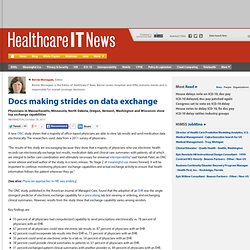
The researchers used data from a 2011 survey of physicians. "The results of this study are encouraging because they show that a majority of physicians who use electronic health records can electronically exchange test results, medication data and clinical care summaries with patients, all of which are integral to better care coordination and ultimately necessary for universal interoperability," said Vaishali Patel, an ONC senior advisor and lead author of the study, in a news release. EHR Implementation Steps: Is Your Practice Ready? View tools for Step 1 Why Implement EHRs?
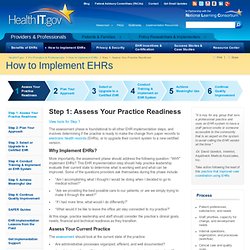
More importantly, the assessment phase should address the following question: “WHY” implement EHRs? This EHR implementation step should help practice leadership evaluate their current state to determine what is working well and what can be improved. Some of the questions providers ask themselves during this phase include: Survey Says: EHR Incentive Program Is on Track. By Karen DeSalvo, MD We continue to see progress in improving the nation’s health care system, and a key tool to helping achieve that goal is the increased use of electronic health records by the nation’s doctors, hospitals, and other health care providers.
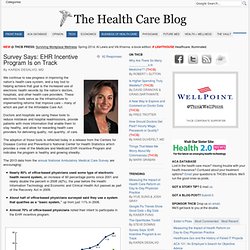
These electronic tools serve as the infrastructure to implementing reforms that improve care – many of which are part of the Affordable Care Act. Doctors and hospitals are using these tools to reduce mistakes and hospital readmissions, provide patients with more information that enable them to stay healthy, and allow for rewarding health care providers for delivering quality, not quantity, of care. The adoption of those tools is reflected today in a release from the Centers for Disease Control and Prevention’s National Center for Health Statistics which provides a view of the Medicare and Medicaid EHR Incentive Program and indicates the program is healthy and growing steadily. Hospitals, doctors have more time to show better outcomes through electronic health records. Getty Images/iStockphoto The idea behind using electronic health records is to maintain more complete patient histories, which can travel with the patient to new doctors and help physicians provide better care.
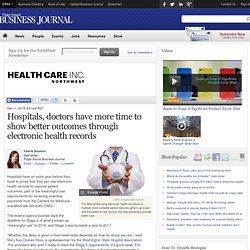
Hospitals have an extra year before they have to prove that they can use electronic health records to improve patient outcomes, part of the meaningful-use requirements for receiving incentive payments from the Centers for Medicare and Medicaid Services (CMS). The federal agency pushed back the deadline for Stage 2 of what’s known as “meaningful use” to 2016, and Stage 3 was bumped a year to 2017. “Whether the delay is good or bad news really depends on how far along you are,” said Mary Kay Clunies-Ross, a spokeswoman for the Washington State Hospital Association. “For providers who aren’t ready to meet the Stage 3 requirements, it’s good news. How are preparations for Stage 2 Meaningful Use progressing. As far as eligible hospitals are concerned, Stage 2 Meaningful Use is in its fourth month.
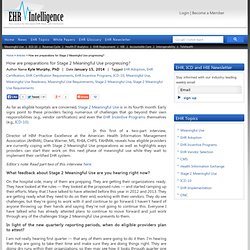
Early signs point to these providers facing numerous of challenges that go beyond their own responsibilities (e.g., vendor certification) and even the EHR Incentive Programs themselves (e.g., ICD-10). In this first of a two-part interview, Director of HIM Practice Excellence at the American Health Information Management Association (AHIMA), Diana Warner, MS, RHIA, CHPS, FAHIMA, reveals how eligible providers are currently coping with Stage 2 Meaningful Use preparations as well as highlights ways providers can start their work on this next phase of meaningful use while they wait to implement their certified EHR system.
How does patient engagement transform into useful EHR data. From Stage 2 Meaningful Use to patient-centered medical homes, patient engagement represents the next aim of healthcare reform through the adoption of health IT systems and services.
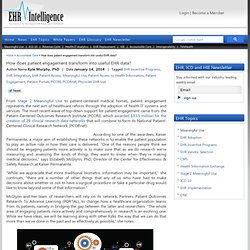
The most recent wave of top-down support for patient engagement came from the Patient-Centered Outcomes Research Institute (PCORI), which awarded $93.5 million for the creation of 29 clinical research data networks that will combine to form its National Patient-Centered Clinical Research Network (PCORnet). According to one of the awardees, Kaiser Permanente, a major aim of establishing these networks is to enable the patient population to play an active role in how their care is delivered. Usability of EHRs remains a priority for ONC. January 6, 2014, 2:00 pm / Jacob Reider, MD / Principal Deputy National Coordinator for Health IT The New Year is a time of reflection and anticipation. We reflect on what went well in the past (and perhaps what didn’t go so well); we anticipate future challenges and accomplishments.
As I reflect on the past, I can see that we’ve accomplished incredible things together. Study shows EHRs help docs boost care. A new study in the journal Health Services Research finds nearly three-quarters of physicians using electronic health records in 2011 said there were clinical benefits when patients' medical histories were kept in digital files. The study focused on doctors' perceptions of clinical benefits to patient care when EHRs were in place. Jennifer King, chief of research and evaluation at the Office of the National Coordinator for Health Information Technology and lead author of the study, explained in the article that physicians with longer experience using EHRs were more likely to report clinical benefits. Researchers looked at the responses from 3,180 physicians to the Physician Workflow Survey questionnaire about their experiences with EHRs. "A majority of physicians said they were alerted to a potential medication error or critical lab value, and about one-third reported that EHRs helped them identify needed lab tests or facilitated direct communication with patients," said King.
Health Care’s Big Data Mandate. Electronic Medical Records and You. That’s the obvious question people have about electronic health records and e-mailing with their doctor. So it’s reassuring that patient portals use firewalls, encryption software, antivirus software, and log-on requirements such as passwords to keep the system secure. That doesn’t mean they are impenetrable. Data breaches have been reported (though most have involved financial information, not medical records). And as with paper records, the office staff, as well as your doctor, may have access to your information and the e-mail you send through the portal.
Ask your doctor or his staff to explain how the portal works in his office. EHR’s & Physician Productivity. A majority of doctors are dissatisfied with EHRs citing productivity losses. But a new study debunks their feelings. The revolution in health information technology (HIT) holds the promise of improving patient care. Since the passage of the Health Information Technology for Economic and Clinical Health (HITECH) Act in 2009, the nation’s hospitals and medical practices have scrambled to upgrade their HIT infrastructure. MMS: Error. EHR Accreditation Could Spur Doctors' Direct Messaging. DirectTrust is on track to accredit intermediaries used by nine EHR vendors that have the bulk of the EHR market. Healthcare Robotics: Patently Incredible Inventions (click image for larger view) Secure clinical messaging via the Direct Project protocol is about to get a big boost from the leading EHR vendors.
Health information service providers (HISPs), which relay Direct messages between providers, are starting to seek accreditation from DirectTrust, a nonprofit trade association. By the end of the year, DirectTrust will accredit HISPs owned by or partnered with nine EHR vendors that serve about 80% of the market, according to David Kibbe, MD, president and CEO of DirectTrust. Accreditation by DirectTrust is important because it allows HISPs to communicate with one another without signing separate agreements that verify each other's trustworthiness. Until recently, HISPs were having difficulty exchanging messages because of the trust barrier.
Electronic Health Records Can Measure Patient-Centered Care. Palomar's app links docs to EHR. Franklin Martin, MD, checks his smartphone. Not for voice or email messages, but to locate patients and nurses – and often, a patient's information. “I use it as I’m walking into the hospital to make my rounds," Martin, chairman of the surgery department at the San Diego-based Palomar Medical Center, said in a statement, adding that the two steps it now takes to log into Palomar’s EHR eases that otherwise cumbersome process.
Martin is one of 50 Palomar physicians armed with Extension Engage Mobile and using it to look up patients, access their medical records, and either call the patient’s room or the assigned nurse directly. The software, which runs on both Apple's iOS and Google's Android phones or tablets, leverages staff assignment data from Rauland-Borg's ResponderSync interface and patient data from the hospital’s Cerner EHR to grant clinicians instant access to information via smartphones or tablets. Will meaningful use lead to reduced costs for hospitals. EHR cost data for docs? Big money saver. Out of control healthcare spending in the U.S. is no secret. Does EHR Adoption Reduce Cost of Providing Patient Care?
The debate goes on about the cost benefits of EHR software and whether it really lives up to the hype. A number of recent studies address this very question as the focus shifts towards lowering patient costs. According the HealthIT.gov, EHR requires both a financial and time investment but the benefits make it worthwhile. A limited number of studies support this claim, however. Access to Medical Records Could Have Prolonged My Husband's Life. 4 ways to make EHR data more personal. Electronic Health Records: Safer Than Paper? The Future of Health Care: Electronic Health Records. 6 tactics for boosting EHR usability. Electronic Health Records Benefits: An ePatient Story. Electronic health records benefits may be clear for providers – cutting redundancy of tests, coordinating care during discharges, etc. — but these benefits also will ultimately accrue to patients in the form of better health.
In July, I participated in the Tenth Annual Healthcare Unbound Conference. Babies were more likely to have wellness visits with online records. Why real-time data matters to successful practice management. ROI vs. EHR Implementation Costs. EHR, informatics, health IT jobs 2.5% of all healthcare hiring. Perspective: Boosting EHR Usability Key to Protecting Patient Safety. AHIMA: Six tips for reducing EHR risks, boosting quality. CMS Releases New Resource on Stage 2 EHR Incentive Program. Education. Survey: Many Confused, Concerned About Digitizing Health Records. Welcome to Forbes. Will EHRs Ever Help Small Practices? - Healthcare - Electronic. EHRs Are Not A 'Digital Menace' - Healthcare - Electronic Medical. What can pain management teach providers about EHR adoption. Enforcing HIPAA Omnibus: What to Expect. Shorten urls, share files and track visits - Owly. Data Exchange Growing through EHR Adoption. Removing The Red Tape From Patient Records.
7 golden rules to optimize EHR implementation. EHR adoption can, should shed light on patient experience. 5 nagging questions about meaningful use Stage 2. New FAQs Clarify More EHR Meaningful Use Measures. New Tool Uses EHR Data To Deliver Personalized Health Care. Wildflower International Electronic Health Records. Report: EHR Adoption in Hospitals Has Spiked Since 2010. Doctors embrace the digital workplace. EHR usability takes precedence during product design: Q&A. How to Prepare For, Survive an EHR Meaningful Use Audit.
The Doctor Is In – Electronic Health Records and You Elsevier. U-M Researchers Call for More Robust Electronic Health Record Data Sharing Capabilities. Community College Program. Clipboard: Hospitals mine electronic health records for marketing data - Boston Medical News - White Coat Notes. Fact Sheets. Eyewitness News 4 Health Fair. Products - Data Briefs - Number 79 - November 2011. HiTech Solutions from Wildflower International, Ltd. Obama's Push to Digitize Health Care Boosts Startups. Epic Systems, Digitizing Health Records Before It Was Cool. Closing the Loop in Health Care Coordination. Wildflower Electronic Health Records. HiTech Solutions. Demostrating Meaningful Use. Implementation/Project Management. Your Business Partner. Education. Assessment/Diagnosis.
Financial Planning. Contact Us. Post EHR Implementation: Achieve Meaningful Use. PT - unlocking potential. 8.300.22 NMAC. EHR Incentive Payment Program.